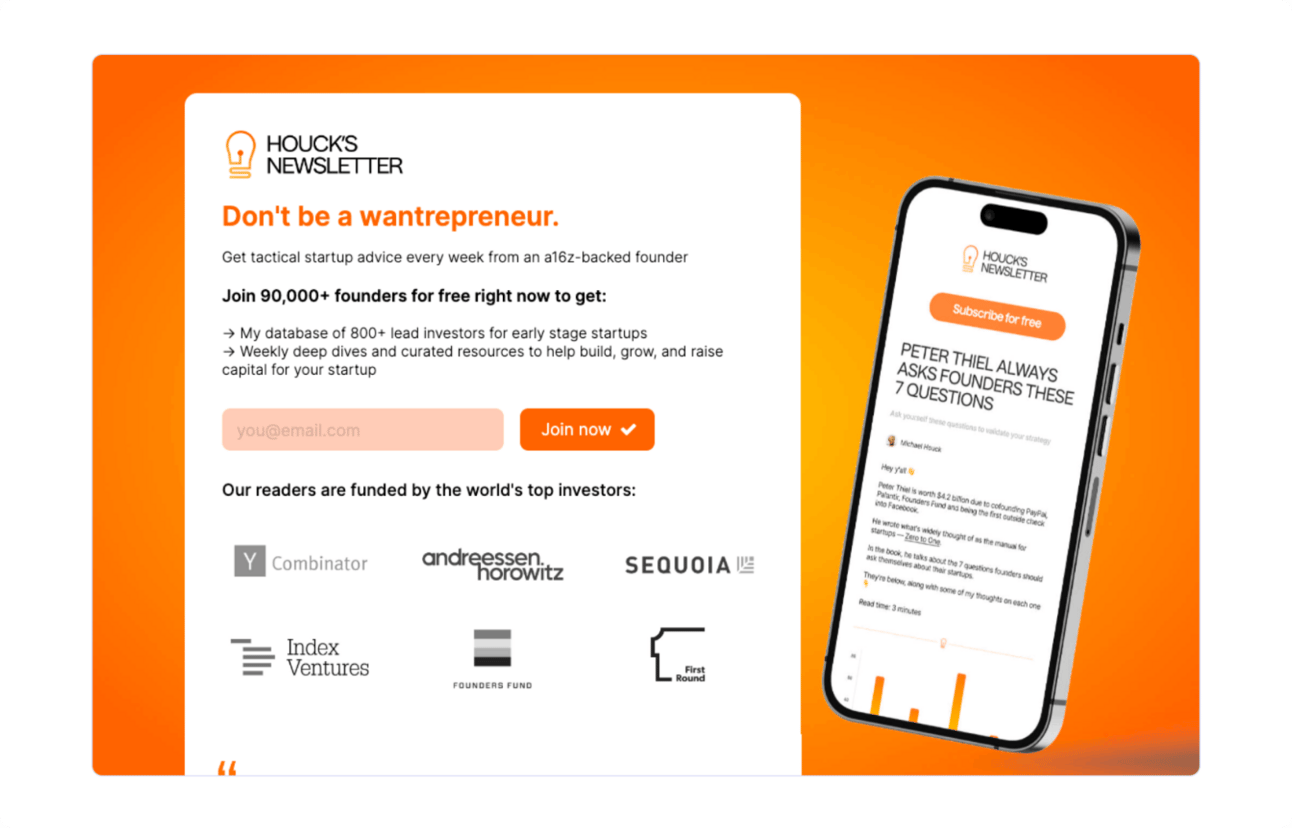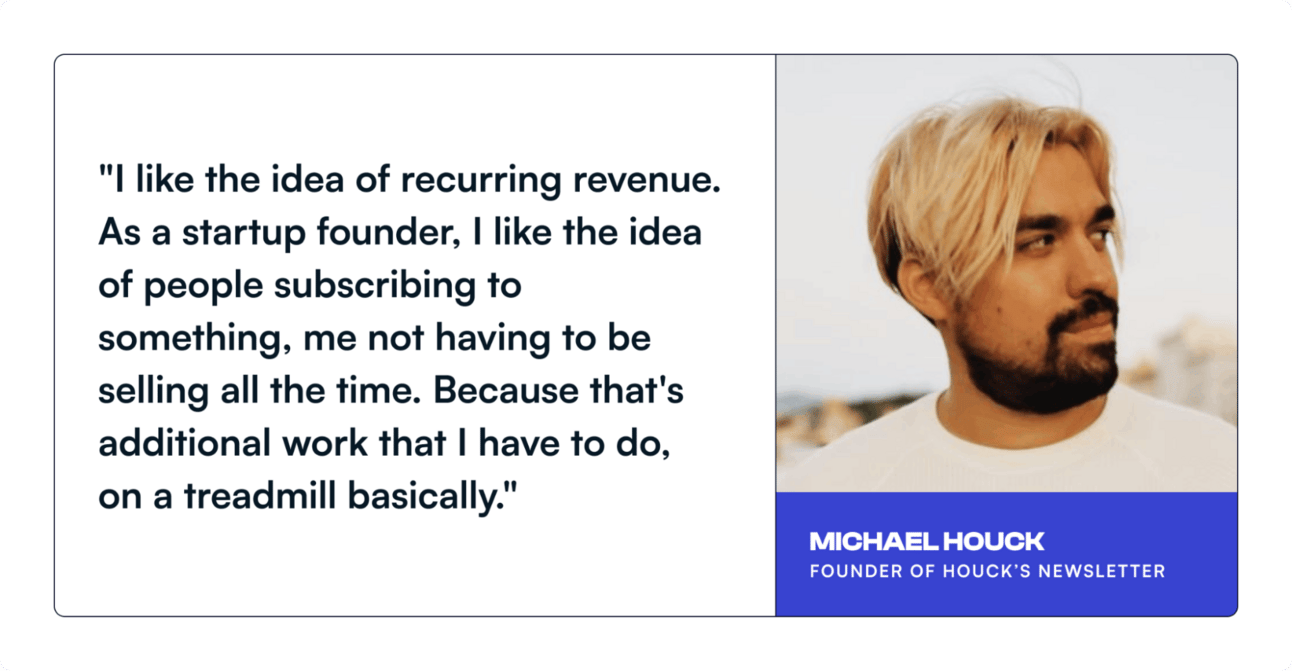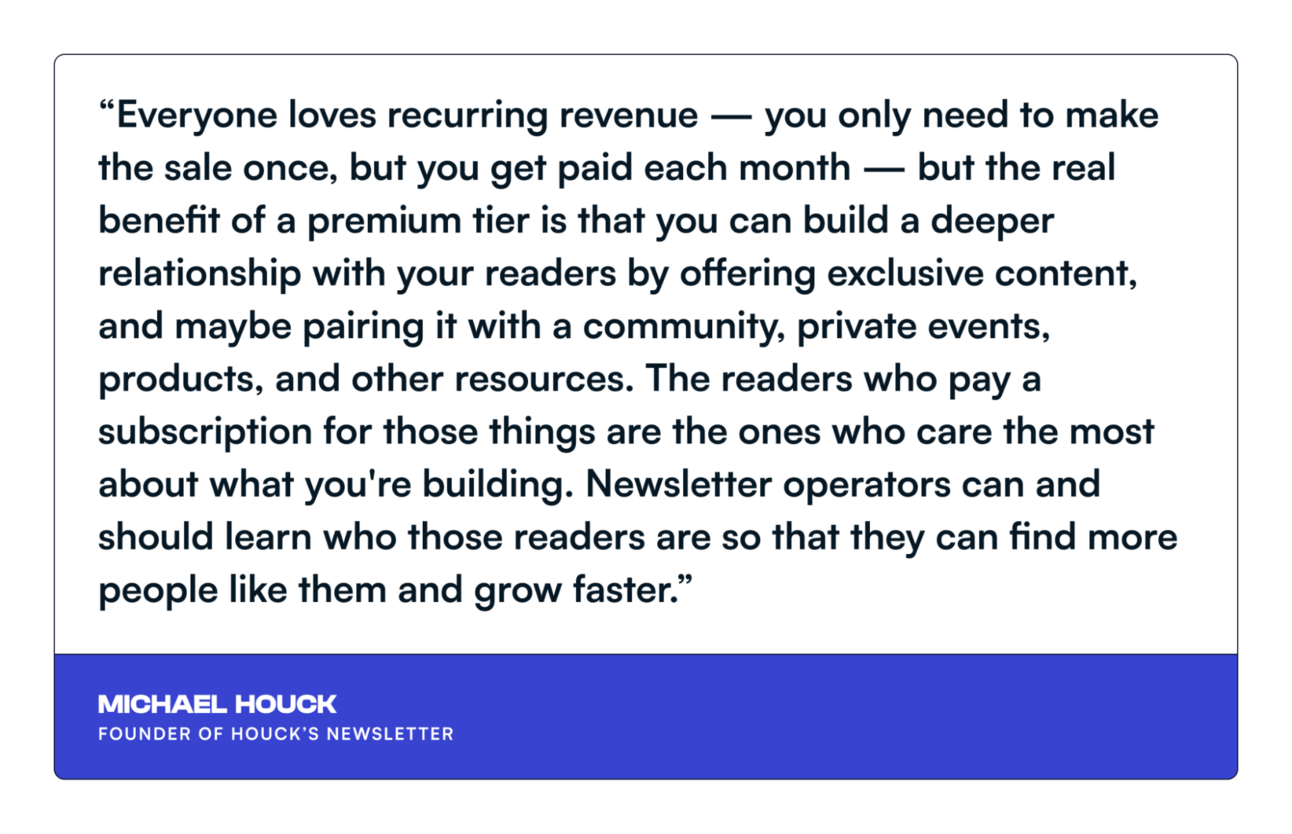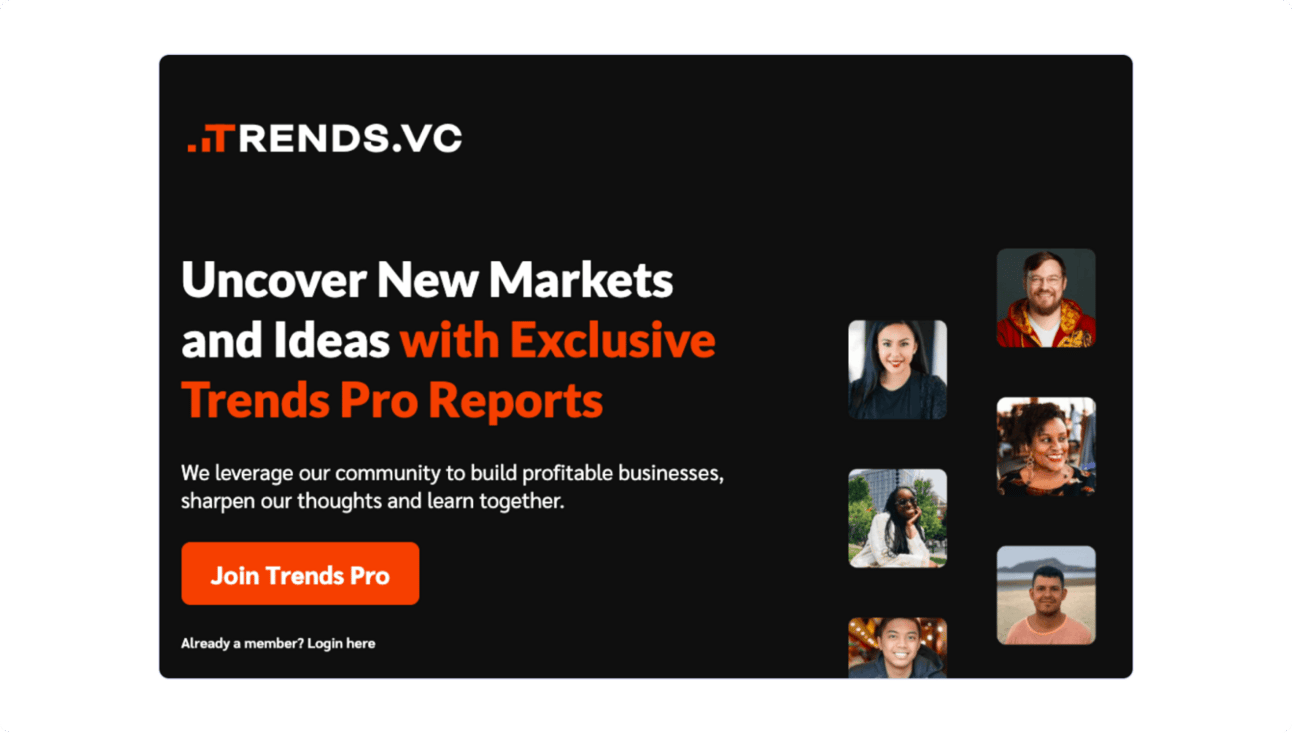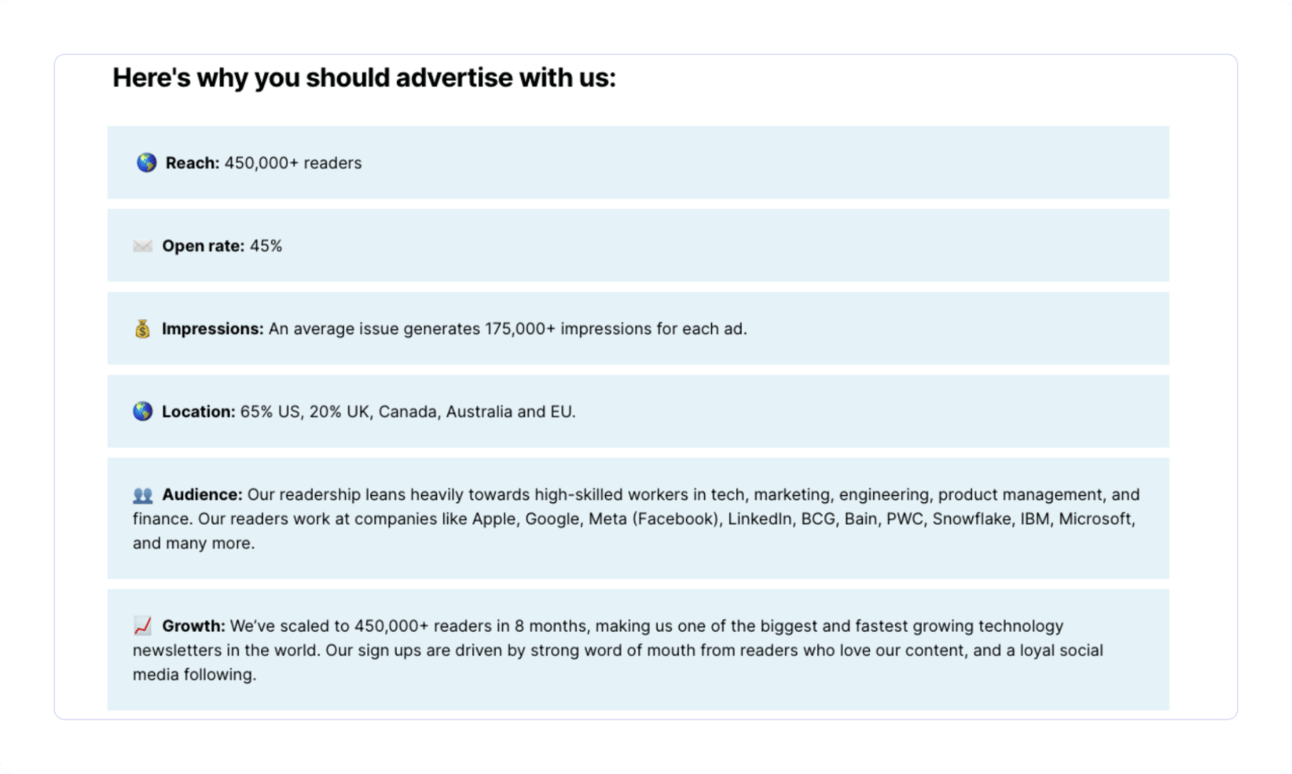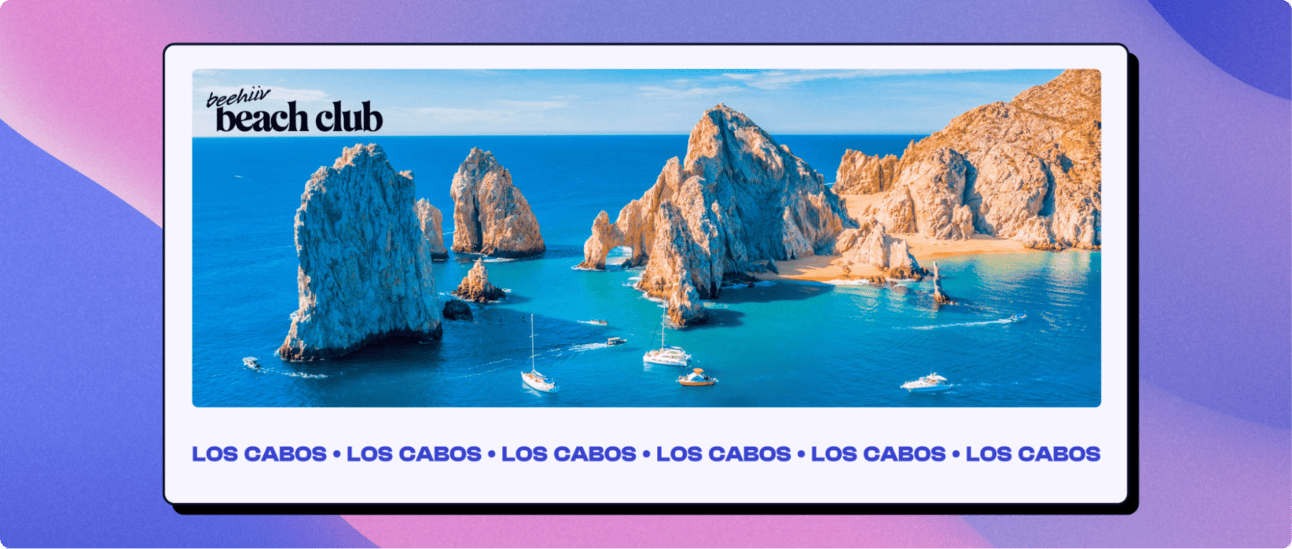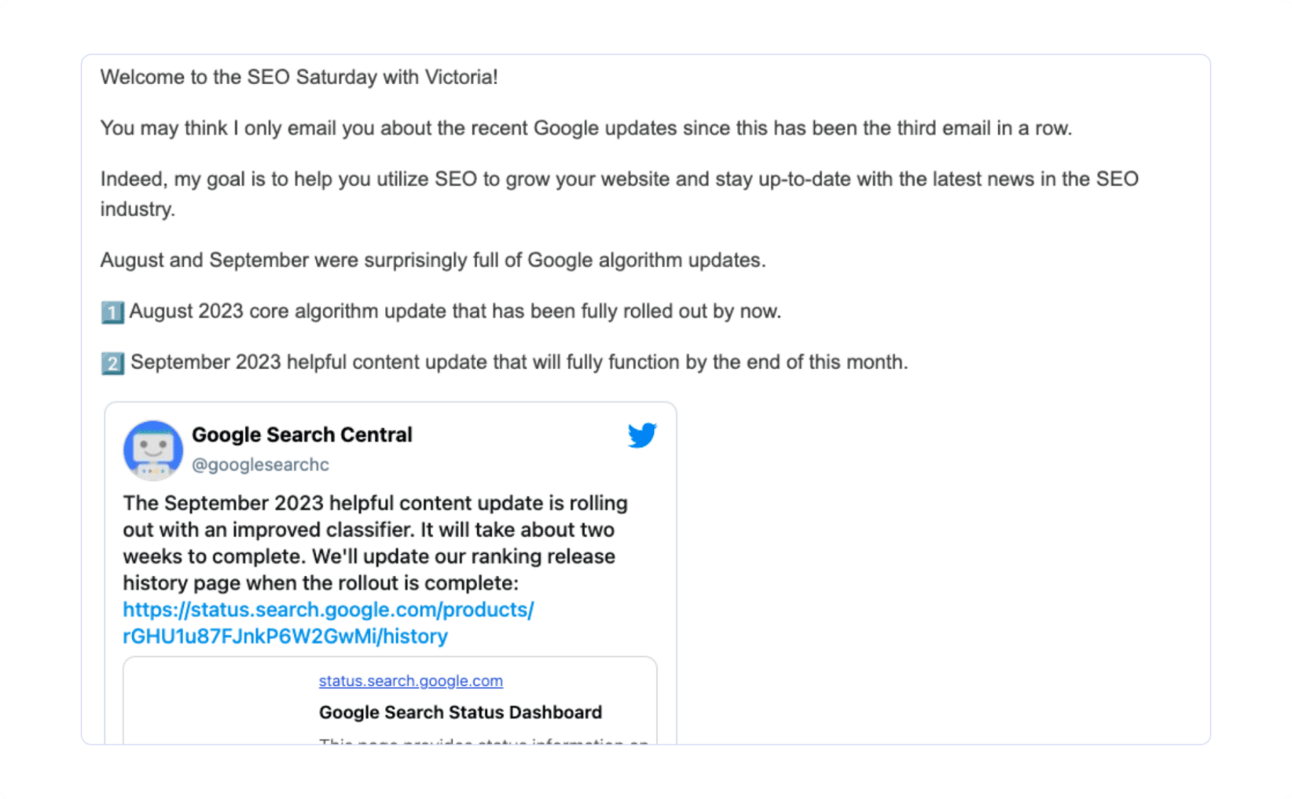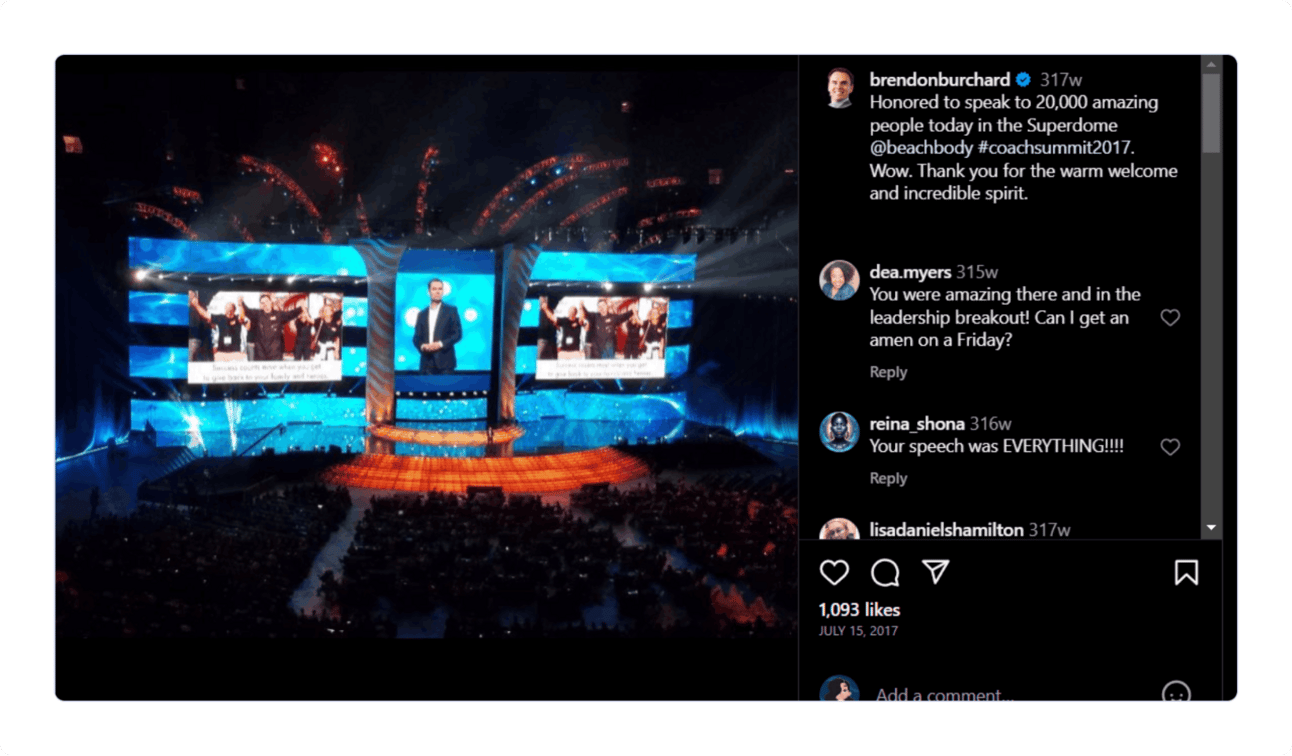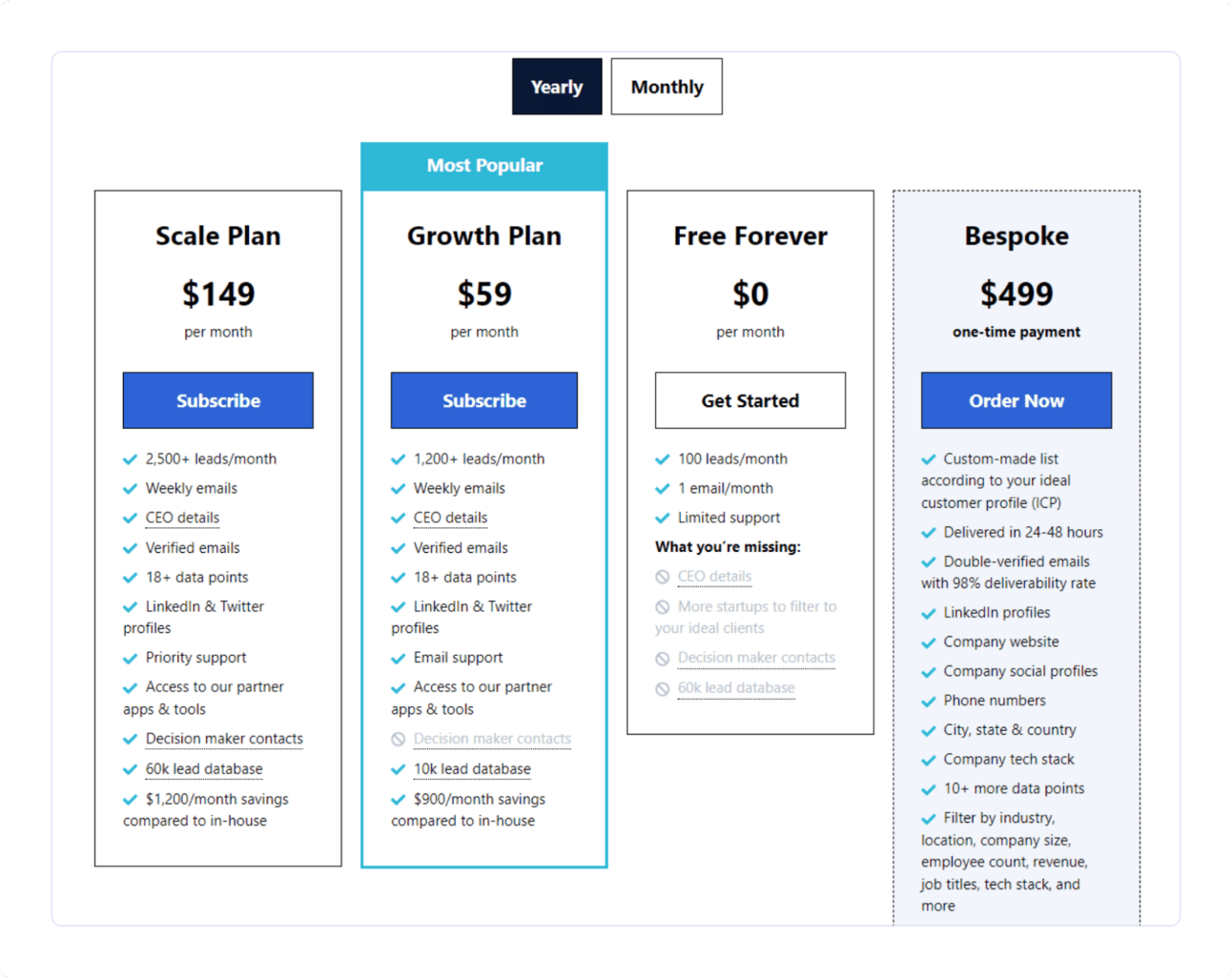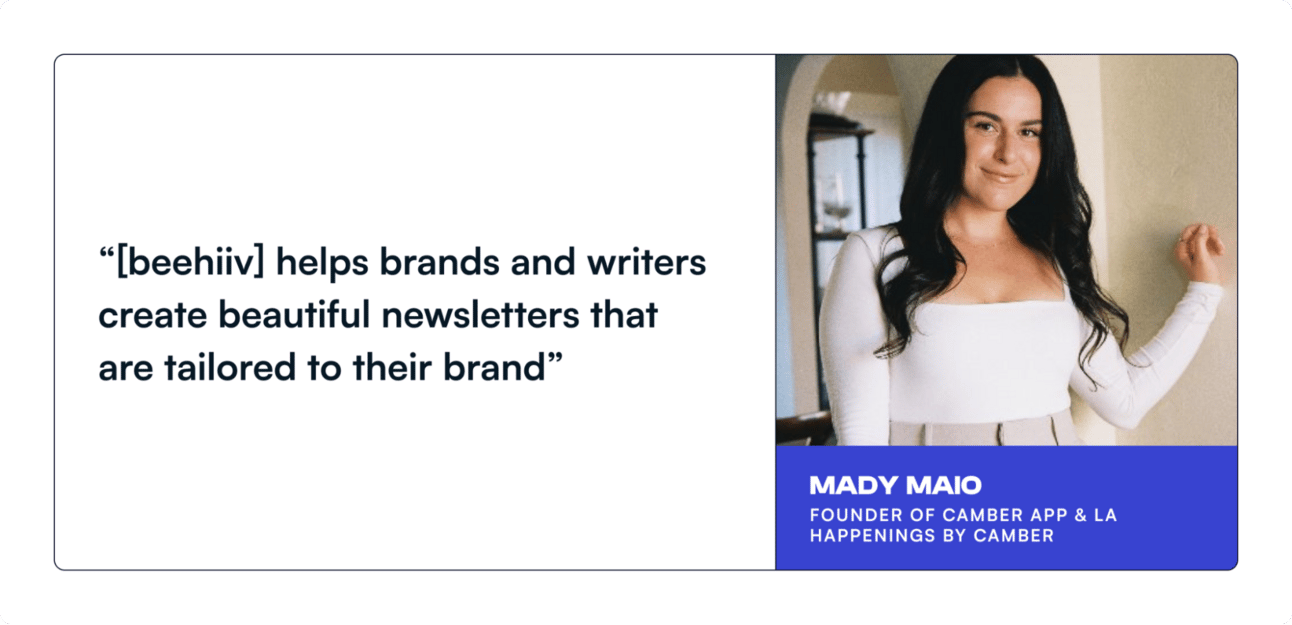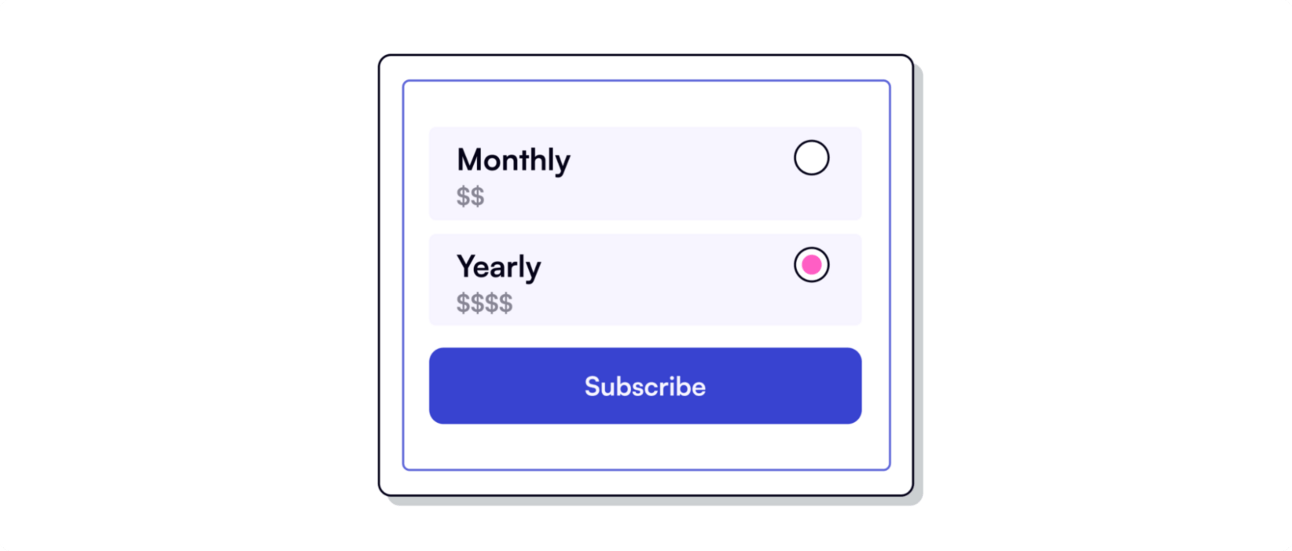When it comes to earning a substantial income online from an owned audience, there’s no greater tool than newsletters.
If you run a newsletter and desire to earn a sizable income, you’re in the right place.
In this guide, we’ll break down 20 different strategies you can use to monetize your newsletter to generate more income outside of just traditional sponsorships.
Let’s uncover the 20 proven strategies you can use to build new revenue streams with your newsletter including real-life examples of creators who capitalized on each method.
A Multi Million-Dollar Newsletter Strategy
Before diving into the 20 methods to monetize your newsletter, we want to share with you some of our insights and trends we’re noticing in the newsletter space.
In the past few years, we’ve seen dozens of new monetization methods emerge for newsletter operators (that we’ll cover below).
Perhaps the most powerful monetization strategy we’ve seen is one that’s often overlooked when building a newsletter: Acquisition.
Since 2020, there have been dozens of major newsletter acquisitions we have been keeping an eye on.
In 2020, Morning Brew was acquired by Business Insider for $75 million, thanks to their 2.5 million engaged subscribers after only 4 years.
In 2021, The Hustle was acquired by Hubspot for $27 million after 4 years.
In 2022, Industry Dive was acquired for $525 million after 10 years.
In 2022, Milk Road was acquired for 7 figures in 10 months.
In 2023, The Peak was acquired for $5 million after 3 years.
In fact, we even have some beehiiv acquisition stories worth reading here.
If there’s something the world is catching onto, it’s that newsletters are incredibly powerful profit-generating machines and worthy media assets to own.
You may be thinking, “well those guys had massive audiences”. But, the reality is that in 2024, you don't need to have millions of subscribers or be a media giant to make your newsletter profitable and very attractive to potential acquirers.
The key is creating niche newsletters for very specific audiences and focusing on delivering value to that audience around your expertise.
20 Proven Ways to Monetize Your Newsletter (With Examples)
With a newsletter, it’s never been easier to cut through the noise of the internet's billion-plus websites and social media viral distractions.
Content is being pumped out at astronomical rates.
Instead of sifting through overwhelming information, readers are wanting a single, reliable source of truth to curate relevant and valuable content.
While a newsletter can serve multiple purposes, having a core objective anchors your efforts, and maximizes earning potential with your niche audience of readers.
We will break down each monetization method below in five parts:
The Strategy: How to plan.
An Example: How others have done it.
One Key Takeaway: What you can learn from them.
Your Next Move: What is the first action step you need to take?
Resources: Dive deeper and learn.
1. 💲Paid newsletter
Launching a paid newsletter (i.e. premium version of your free newsletter) is one of the most popular ways to monetize your newsletter.
The secret to premium subscriptions?
Creating a community of enthusiasts who value your insights enough to invest in them.
♟️The Strategy
Select a high-value niche where the audience is hungry for specialized insights only you can provide. Offer the majority of your content for free, showcasing unique and exclusive knowledge.
This strategy builds trust and positions the paid newsletter as the exclusive source for premium, indispensable insights, compelling subscribers to invest in the remaining 1% of your exclusive content.
Shaan Puri and Ben Levy combined their passion for cryptocurrency with a commitment to providing simple, understandable daily content.
They leveraged the power of paid social advertising, primarily on Facebook and TikTok, to rapidly grow their subscriber base.
The Milk Road was acquired in 2022 for seven figures. In 2023, they started a paid subscription tier to provide more value to their audience.
📝Key Takeaway
Milk Road succeeded by focusing on a high-value audience, providing mostly free, valuable content, and positioning their paid subscription (many years after launch) as an exclusive source for indispensable insights with a limited-time offer.
Their free content was not just curated crypto news, but insights backed by logic – making the audience feel smarter.
👷 Your Next Move
Offer free insights that solve real problems. This strategy hooks your audience, creating a need for your premium, exclusive insights.
You don’t need to sell yourself (directly), start by sharing sneak peeks of your premium content on social media channels like Twitter to create a sense of FOMO and redirect people to opt for a paid subscription to your newsletter.
📕Resources
While a paid newsletter offers readers the chance to read a newsletter with greater depth & value, a paid community offers readers the chance to step into a newsletter creator’s “inner circle” and build unique relationships.
It’s a dynamic space where readers become members. It enables subscribers to form meaningful connections, engage in valuable interactions, and collaborate toward mutual goals.
Unlike one-way content consumption, a paid community fosters two-way communication.
♟️The Strategy
First, define diverse interaction avenues—discussions, polls, live events—ensuring varied engagement opportunities. Next, strategize membership tiers, offering distinct benefits or equal access to cater to diverse preferences.
A well-defined launch plan, involving subscribers in the pre-launch phase, generates anticipation.
Houck’s Newsletter is a publication geared towards founders that helps them advance their startups, find investors, and raise capital.
Michael Houck offers a free newsletter to his list of 90,000+ subscribers that’s jam-packed with valuable insights for founders to succeed with their startups – including firsthand experience as a founder himself.
After someone subscribes to Michael’s free newsletter, they’re immediately given the opportunity to join his private founder’s community with a free 14-day trial.
750 founders have become members so far. He charges $15/mo or $150/year.
Members pay just $15 per month to gain access to a wide spread of features like:
Access to his private community
Workshops, masterminds, and meetups
Founders resources and curated perks
Now, Michael’s earning more than $100,000 per month from his newsletter. That’s more than most people make in a year at a regular job.
📝Key Takeaway
It didn’t take long for Michael to get his newsletter off the ground. He sought advice from others who have gone before him in the newsletter space like Sahil Bloom and Lenny Rachitsky.
Within a year, Michael was able to grow to about 90,000 subscribers. Michael also leveraged giveaways on X (Twitter) to grow his list. This strategy got him to 10k within weeks.
👷 Your Next Move
Paid communities typically center around specific niches– start by organizing virtual meetups, webinars, and networking events through your newsletter. These events will facilitate connections among like-minded folks, and that’s exactly the kind of engagement we need to kickstart a paid community.
There are many ways to structure communities, access, and pricing. Listen to your audience to structure your community in a way that brings value.
📕Resources
3. Curated Content
Curated content combines the elements of a digital product with a paid newsletter.
In a way, curated content is a blend of the two. Like many of these strategies there is a very natural crossover.
Curated Content often comes in the form of a premium report, usually for a B2B audience.
The perk of launching a newsletter with an option to upgrade to curated content is that the audience doesn’t have to go through hundreds of websites to know about a particular topic. They’re paying for curated access to niche knowledge.
They can dive super deep into a topic, accessing up-to-date industry data, research, and breakdowns in a quick, simple delivery method — a newsletter.
This works extremely well when you dive deep into a niche. Avoid broad curation when possible.
♟️The Strategy
Deep-dive into industry trends with exclusive data-driven insights while offering subscription tiers, granting access to varied perks like early content access and advisory services. The curated content should be more insightful than just giving away information. Find your unique edge.
These tiers cater to different subscriber needs, from basic content access to personalized guidance, fostering value and engagement.
Dru Riley, the founder of Trends.vc, transitioned from a software engineering job to pursue his entrepreneurial journey.
He explored multiple business ideas before launching Trends.vc in 2019. Despite gaining subscribers and recognition, he initially struggled to monetize effectively.
Dru's key breakthrough came with a tiered monetization model, offering premium insights within his free reports.
Each of his curated reports includes a few sections like:
The problem a certain trend solves
Those leading the trend in the industry
Dru’s predictions for the trend
The opportunities and risks associated with the trend
Key lessons on how to implement those trends.
“Haters” – which features the opposing take on the trend from others in the space
📝Key Takeaway
Test various offers to engage your subscribers. Dru successfully implemented an annual subscription for bi-weekly reports and community access, boosting visibility by featuring others in his content and sharing it on platforms like X.
Collaborations can amplify your content's reach as featured parties often reshare it. His partially free reports help him tease out content while leaving people wanting more.
👷 Your Next Move
Dig into your audience’s pain points via surveys and forms to identify a knowledge gap you can fill with curated & researched content.
Bonus Tip: Only curated content is not quite enough, make sure you have a unique edge that adds more value to your curated insights. Your unique opinion and insights will help make your voice one of one.
📕Resources
Sponsorships, or sponsored ads, are one of the most popular & common ways to generate revenue from your newsletter. This is typically the default monetization strategy most newsletter operators use.
The idea is once you’ve built up a decent-sized subscriber base, you can leverage your reach and engagement to persuade congruent brands to advertise in your newsletter.
When you share sponsored content that interests your target audience, it creates a win-win-win situation: your audience gets even more value, the sponsor generates awareness + sales, and you earn ad revenue.
♟️The Strategy
The key is to stay true to your audience. Only partner with sponsors whose products or services genuinely benefit your readers and that you personally believe in.
Also, craft a sponsorship page – outlining sponsorship opportunities. Include key details like your audience stats, ad formats, and contact information.
Zain Kahn writes an AI daily newsletter to — get this — 450,000 people. Yes, he has nearly half a million subscribers on his beehiiv newsletter.
Zain places at least one sponsored ad in every single issue. He charges advertisers a fixed amount for each ad placement, which includes a graphic and written copy about the sponsor's product or service.
At 450,000 subscribers, his primary ads start at $2,500. Yep, he earns $2,500 for every featured ad he places in his issue — and he sends these out every day.
Zain does a great job of selling his advertisers on why they should sponsor his newsletter.
Once they click through, they’re taken to a landing page where they can see how valuable Zain’s audience and engagement are.
📝Key Takeaway
Leveraging beehiiv's audience acquisition data and UTM integration, Zain tracks reader sources for audience growth. Analyze detailed acquisition data and optimize growth strategy using UTM tracking. This will also help you stay transparent with your sponsors and tell them exactly what your audience is all about.
👷 Your Next Move
Implement UTM tracking, surveys, and build an audience profile to show off to potential sponsors. Once you know the insights, you will be able to clearly communicate the value advertisers receive in exchange for their investment.
📕Resources
5. 🧾Affiliates
Affiliate sales are a shift from conventional promotions to a strategic recommendation-based approach. You promote a product, someone clicks your link (and buys someone else’s product), no fulfillment, and you get paid a commission for the sale.
The potential for earnings as an affiliate is limitless and will often far exceed sponsorship revenue if you’re willing to bet on your audience's engagement.
♟️The Strategy
Instead of simply promoting affiliate product links, provide in-depth analyses and comparisons. Explain why you recommend these products, highlighting their features, benefits, and potential drawbacks. This is all made easier of course if you are a customer yourself (which we recommend).
You can even create newsletter editions that feature a selection of different curated affiliate products. Organize them based on specific themes or needs that resonate with your audience.
While developing his newsletter agency, he found out about beehiiv and quickly fell in love with the platform.
Soon after, he started recommending beehiiv to all of his agency clients (and his newsletter subscribers). When beehiiv launched its partner program, he hopped on board immediately.
In addition to recommending it to his newsletter audience, he also pushed the benefits of beehiiv and his agency’s preference to prioritize newsletters on beehiiv.
The crazy part is — he earns 50% commissions (for an entire year) every time someone signs up to beehiiv through his partner link. This means if someone gets beehiiv’s Grow plan at $49/month, he’ll earn $24.50/month for a year ($294).
If five people sign up for beehiiv’s Scale plan through your affiliate link at $99/month, you’ll earn $247.50 every month on autopilot (or $2,970 total).
In 2023, Matt was the first winner of beehiiv’s Beach Club – a beehiiv partner giveaway that offers quarterly trips around the world for the person who generates the most affiliate sales that quarter. Not only did Matt earn thousands as a beehiiv affiliate, but he also won an all-inclusive round trip for two to the Atlantis in the Bahamas.
📝Key Takeaway
Your endorsement adds authenticity to your recommendations. The more you believe in the product, the more likely your audience will as well. If you understand their wants and needs (it also makes it easier to sell them on it).
Also, be transparent with your affiliation, and clearly disclose that it's an affiliate promotion to build trust with your audience. Being honest with your audience will build trust leading to more affiliate commissions long term.
👷 Your Next Move
Identify relevant affiliate products in your niche that can bring your audience value (Ideally, products that you actually use).
Get your own unique affiliate link, and remember to include them in your newsletters organically and analyze the performance.
Bonus tip: With the beehiiv partner program you can earn 50% of revenue for referring new paying customers to beehiiv, no matter what your niche is. Get started here.
📕Resources
6. Courses
Through your newsletter you already share valuable knowledge. Now it is time to package that knowledge up and deliver it. It can be about writing, designing, managing finances, or just about anything related to your specific niche. Courses offer a great way for you to package up your knowledge.
♟️The Strategy
Understand What Your Audience Is After. It’s important to know what your audiences’ pain points are, especially when it comes to the knowledge they’re after.
Once you know this, you can validate audience demand. Start by solving one specific problem for one specific person in one specific way. Then, introduce the idea of a course to test the waters. Let your audience know you’re thinking of creating one and see what kind of response you get.
Justin Welsh transitioned from a SaaS advisor to a successful Solopreneur, earning $1.3 million per year from his course.
Step 1: Create a hub piece of long-form content (via newsletter).
Step 2: Chop your hub content into relevant sub-topics.
Step 3: Stagger the content over 4-6 weeks
Step 4: Point your social content back to your newsletter.
Step 5: Promote an in-depth course related to the knowledge you’re offering via newsletter.
📝Key Takeaway
Leverage testimonials to drive promotions. The quicker you can gain those first few testimonials, the better your course will sell. Your best sales strategy is Proof. You could even give it away for free to some people to review it ahead of launch time.
👷 Your Next Move
Ask your audience what topics they want to learn more about (and what they’d be willing to pay for). Develop small ebooks and PDFs around different topics to see what sticks. These can be actual snippets from your course or they can act as validation of what people want that you can turn into a course.
Similar to comedians refining jokes for their special performances, this approach allows you to test content snippets from your course before finalizing them.
📕Resources
7. 📱Digital Products
Offering exclusive digital content, tools, or resources tailored to your audience's needs can not only drive revenue but also deepen engagement and provide added value.
This approach transforms the newsletter into a platform for delivering premium, specialized digital products, catering directly to subscriber interests while enhancing the newsletter's profitability. Digital products are typically one-time assets available for purchase.
♟️The Strategy
Develop a series of in-depth guides, each focusing on a specific subtopic within your niche. These guides should offer practical advice, strategies, and expert insights for your subscribers to implement. You can also create value-packed bundles by combining multiple guides into a single package. Encourage your subscribers to make multiple purchases, increasing your revenue per transaction.
To enhance your digital products, incorporate interactive elements like quizzes, assessments, challenges, or exclusive access to webinars and Q&A sessions. Digital Products can be guides, books, recordings, etc.
Victoria, an SEO expert, started on Medium, then she launched her own website and a beehiiv newsletter. Over time, she started seeing her audience had the same issues over and over again, so she launched an SEO guide as an extension of her offering.
To get more subscribers and warm leads to the idea of an ebook, she started offering a free guide.
Now, she offers a variety of digital products (and even pitches her SEO services) using Gumroad.
📝Key Takeaway
Explore what your audience is searching for and struggling to find and align your digital product creation with these needs. Develop a series of comprehensive guides, books, tools, research, etc., each tackling a specific aspect of your niche.
Craft these to provide practical, actionable advice, ensuring they add genuine value to your subscribers.
👷 Your Next Move
Determine what type of digital product can solve your audience's biggest problem while crossing over with your unique knowledge/skill set. Highlight your product's credibility by sharing relevant statistics and collaborations with experts within your niche.
📕Resources
8. 🚀 Boosts (Paid Recommendations)
One of the best organic growth tools on beehiiv is called Recommendations. It’s a feature that organically recommends other newsletters to your subscribers right after they sign up.
beehiiv offers a paid version of this feature called “Boosts.” It lets you place paid recommendations at the top of the list for your new subscribers. If they sign up for your recommended newsletter, you get paid… Every. Single. Time.
Think of it like a micro-sponsorship or affiliate strategy.
Boosts can be placed directly in your newsletter issue or shown during a subscriber sign-up flow.
Boosts is one of the fastest ways to start earning from your newsletter, because you don’t need thousands of subscribers to get started (and it can be set up in minutes).
♟️The Strategy
beehiiv’s Recommendations let you add value to your subscribers by recommending other relevant newsletters within the beehiiv network. With beehiiv Boosts, you can get paid to recommend featured newsletters to your subscribers.
The bigger your subscriber base is, the more you’ll Boost subscribers to recommended newsletters. This means you get to scale your earnings without doing more work.
Boosts is a two-way street. You can either use it to generate revenue by recommending other newsletters. Or, you can leverage it as a paid growth channel to skyrocket your list size as a sponsored recommendation.
Rowan Cheung runs an AI newsletter called the Rundown AI with over 400,000 readers. He’s one of the fastest-growing newsletters on beehiiv and also one of the highest-earning publications.
Rowan leverages beehiiv Boosts to earn more with his newsletter and has already made $8,000 in total Boost revenue.
📝Key Takeaway
To start monetizing as quickly and easily as possible, make sure you choose a newsletter platform that gives you easy access to monetization tools (like beehiiv).
Also, remember that not every newsletter will be a good match to recommend as a Boost. Partner with those in your niche that you believe will add value to your subscribers. We recommend other newsletters with a similar audience but aren’t direct competitors in what you sell.
👷 Your Next Move
Sign up to beehiiv’s Scale Plan (free trial). Explore beehiiv’s Boost network for potential newsletter Boosts. Subscribe to potential newsletters to get a feel for their content. Then leverage Boosts within your sign-up flow and your newsletter directly to start earning! You can also create recommendations and boost partnerships within our hiiv community here.
📕Resources
9. 📱Consulting/Coaching
Integrating consulting and coaching into your newsletter monetization strategy can be a natural extension. It can help foster deeper connections and personalized interactions with your audience.
These services provide an avenue to directly address your subscribers' needs, offering tailored guidance and expertise beyond the newsletter content.
This approach not only adds value but also cultivates a loyal community eager to invest in personalized solutions, thereby amplifying your revenue streams.
♟️The Strategy
Tailor consulting services by identifying community pain points, and ensuring transparent packages with clear deliverables and pricing. Offering services on the backend of your newsletter is an incredible way to drive revenue for your newsletter quickly. Where can your experience be packaged up and delivered as a consulting service that solves a pain for your audience?
Jade started off by focusing on LinkedIn and grew to 150k followers in 5 months. Her newsletter, The Quiet Rich covers all the ways a person is rich, whether that’s in time, health, relationships, etc.
She offers 1:1 consulting at $1,499 as she has established herself as the expert leveraging her work at Google and LinkedIn.
📝Key Takeaway
Be Specific About What Your Coaching Will Offer. Explain how long the coaching lasts per session, what steps you’ll take, and what happens after the call. Be clear if you offer recurring monthly coaching sessions or just one-off sessions.
👷 Your Next Move
Build a landing page for your consulting calls that can give people clarity on what to expect from you and why to trust you.
Let your subscribers know you offer coaching or consulting (even if you haven’t figured it out yet). You’d be surprised at how many times coaching happens due to subscribers reaching out first. If you’ve got a list of at least 500 people, there are likely already subscribers who are willing to pay for your expertise.
Bonus Tip: An easy way to link to your consulting is leveraging a paid calendar booking page via a tool like TidyCal or Calendly which both integrate with Stripe to easily charge for your time.
📕Resources
10. 🧑💼Job board
When you share content that talks to people about work, life, wealth, etc. – having a job board can be a great addition to your newsletter.
Your subscribers trust you with your content, they look up to you and they’d love to apply for jobs through you.
From the other end, if companies know their next employee could be someone from your audience, they’d love it too.
♟️The Strategy
Set your job board apart by curating listings aligned with your content themes, ensuring credibility through rigorous vetting. Enhance the board with resources for skill development, promoting upskilling and employability.
You can also forge partnerships with socially responsible companies, highlighting roles contributing positively to society and the environment to attract conscientious job seekers.
Lenny segmented his job postings into three categories: Standard, Featured, and Bulk.
The key reasons a job board worked so well for him:
Lenny already shared insights related to work, finance, and product management which helped him build an audience of employers and employees.
He gives access to his audience database to the job posters.
He also gives access to exclusive job postings to his subscribers.
📝Key Takeaway
Start small by offering a simple job board to your subscribers via newsletter. Simply offer a paid subscription for access to the latest job listings in your niche. Also, Prioritize the development of a robust and valuable database. Concentrate on building relationships with sponsors and engaging your audience effectively.
👷 Your Next Move
Share insights on the top job roles where you have your expertise (like a trial). Analyze people who show interest in specific blogs and insights.
Then experiment by sharing 1-2 job postings in your newsletter and understanding if people are interested before expanding to a full job board.
📕Resources
11.🌐Events
Hosting events is one of the biggest leaps towards building a dedicated audience. While courses, memberships, and online coaching programs are a way to bring your audience closer to you online, in-person events are one of the most powerful ways to create lifelong fans.
The way you earn is simple. Offering premium access to exclusive events directly converts into revenue through ticket sales to your engaged subscribers. And, depending on how elaborate the event is, you could create an entire business model out of it, earning six or seven figures per year.
♟️Strategy
Segment Subscribers. Organize your email list based on interests and engagement levels.
Anyone who’s signed up for your course, attended a workshop, or has done coaching with you is a prime target.
“Who do I want to reach and where are they?”
Consider the analogy of 100 angel investors being more valuable than 10,000 college students – The quality of your audience will tell how valuable your email list is.
Sam Parr reverse-engineered the event model by targeting Silicon Valley demographics to build the Hustle Con conference.
Just six weeks after launching his newsletter, he grew to 4,000 subscribers and generated $60k in revenue from just 350 attendees. And this was his first event ever.
📝Key Takeaway
Engage with the right individuals who share similar interests, values, and aspirations. Meaningful connections can lead to collaborations and exclusive opportunities. People attend conferences for the people they will meet rather than the content consumed. Once you know your target audience, work on building expertise, credibility, and thought leadership to enhance your influence.
If you’re strapped for cash flow, consider offering early bird tickets via a pre-sale to fund the event (and build hype for your audience).
👷 Your Next Move
Reverse engineer your way by collecting insights about your target audience’s interests, challenges, and preferences. Now what type of event (IRL or virtual) can you launch? Also, attend a live event yourself to get a feel for how they market (and deliver) to their audience. It will be a good way to see if it’s the right kind of model for your newsletter.
📕Resources
12. 🪩Experiences/Tours/Recommendations
When planning to travel to a new city, we always want to know the best places to eat, visit, and explore. This is where local-based newsletters shine.
The credibility of these local newsletters builds profound trust among locals and travelers, creating avenues for monetization.
Businesses actively seek exposure to the engaged audience, transforming the newsletter into a sought-after platform that connects authentic experiences with profitable partnerships.
♟️The Strategy
Establish a platform within your newsletter for subscribers to offer their own experiences, tours, or recommendations for a fee. If you don’t have a local newsletter, collaborate with local businesses to provide special discounts and packages for your subscribers, creating mutual benefits.
Curate bundles of experiences around specific themes or interests, such as the "Foodie Adventure Bundle" or "Art and Culture Bundle."
The B-Side is a local newsletter run by the Boston Globe that covers food and drinks, culture, events, and the latest news in Boston.
A niche audience: Gen-Zs living in or traveling to Boston.
High-value content: News, events, underrated places to eat, escapes, etc.
Advertising and event listing option: Weekend events happening in Boston.
A strong online presence along with the newsletter: Twitter, TikTok, etc.
The B-Side does a great job of constantly filling its readers in on new experiences and events going on in the city. In fact, they do such a good job of hyping up the different experiences and recommendations that it’s hard to tell if it’s a paid sponsorship or just a random recommendation, as is the case with the sponsored ad below for The Current.
📝Key Takeaway
Centering on Gen-Zs in Boston, B-Side crafts high-value content for this niche. Expanding beyond the newsletter, it maintains a robust presence across platforms like Twitter and TikTok. Monetization stems from advertising opportunities and event listings, leveraging the platform's reach and engagement for revenue generation.
👷 Your Next Move
Consider offering personalized services like travel consultations, advice sessions, fun events or workshops. Along the way, try finding and collaborating with local businesses that resonate with your audience. Bolting on fun IRL experiences for your audience can be a great way to bring value.
📕Resources
13. 🎤Speaking Gigs
Your newsletter gives you the power to make an impact through written words. But, it also offers the opportunity to expand your reach through other mediums like speaking gigs. The newsletter plants the seeds of trust and expertise. Speaking Gigs can deliver this expertise directly to your audience's doorstep.
♟️The Strategy
Building a robust personal brand through your newsletter can attract opportunities to share your insights and knowledge at events, conferences, and webinars (IRL or virtual). Leverage your newsletter to drive in paid speaking opportunities for your brand.
Brendon Burchard is a New York Times bestselling author and a high-performance coach who has over 10 million followers across his brands.
Brendon’s Sunday Growth newsletter has 2 million subscribers where he shares new strategies every week on how to make self-improvement a way of life.
His influence isn’t just limited to his books, courses, or newsletters. His events are always all sold out.
This example might make you wonder how you could possibly get to the same level. Rest assured, there are ways you can do it too, even with a newsletter list 100 times smaller than his.
📝Key Takeaway
Align your image with content and expertise, like Brendon Burchard, to attract speaking opportunities. Offer content that resonates with your audience – thanks to omnichannel marketing you can leverage short-form video content on platforms like Instagram and YouTube to showcase your public speaking side and boost credibility.
Begin with smaller speaking gigs to monetize expertise, leveraging these opportunities to promote your newsletter and products to engaged audiences. And vice versa leverage your newsletter to fuel your speaking.
👷 Your Next Move
Go live on platforms like Instagram as well as X Spaces to talk to people and observe how the interaction goes.
You can also extract short video clips or impactful quotes from your podcast interviews to not only grab people’s attention but grow your audience.
📕Resources
14.🧑💼Agency or Productized Service
By building credibility within your niche, you build a foundation for starting an agency or offering a productized service.
Since your audience already values your knowledge (ongoing theme here) and content, a percentage will likely consider services you choose to offer.
♟️The Strategy
Build a Sales Funnel by using lead magnets, email sequences, and retargeting ads to nurture leads into paying clients over time. Your newsletter is an incredible nurturing tool. Extend your services to subscribers who have shown interest in your work.
Smart Nonsense is a daily comic newsletter by Henry Belcaster and Dylan Jardon, and Clipt.co is their agency that creates impactful animation videos for creators as well as brands.
They started off by creating videos for podcasts, creators, and founders, and in less than four months, Clipt.co went live.
📝Key Takeaway
Having a value proposition can highlight how your service targets the common pain points of your clients – for Smart Nonsense it is about delivering world-class animated videos in less than 24 hours.
Don’t be boring. Creativity Sets You Apart. Smart Nonsense’s videos on YouTube and newsletters on beehiiv are the best salespeople for their agency. The high-quality content speaks for itself and often has people asking “Who does the animation for you guys?”
👷 Your Next Move
Look at your personal skills and where those overlap with services your audience needs help with. We suggest offering more of a productized service as it is much more packaged with the value clearly defined for your audience. Your newsletter can now clearly push people to a valuable service offering that is congruent with your already existing newsletter theme.
📕Resources
15. 💾Access to Data or Database
We live in the internet era where Data = Gold.
Giving people access to valuable niche data can be a powerful way to turn your newsletter into a passive income stream.
♟️The Strategy
Establish a content cycle where subscribers regularly access fresh insights for ongoing data. Highlight how your data leads subscribers to achieve real results (leads, industry reports, etc).
Emphasize your offering's promise of practical advice, setting it apart from generic data sources.
Growth List has a freemium model that offers access to leads and details that offer email leads every week for your business.
They highlight how subscribing to Growth List offers a remarkable return on investment (their leads can make you $). The service is positioned as a time and cost saver, with a focus on increasing business closure rates.
They reassure potential users that their clients use reports in diverse ways, targeting specific industries, locations, and outreach methods.
They have a database of newsletter sponsors that is updated frequently and provide you access.
📝Key Takeaway
Transition from a scarcity to an abundance mindset, acknowledging the richness in seemingly simple concepts. Focus on niche growth over breadth to foster deeper connections with engaged audiences. Mitigate subscriber risk by offering a freemium tier, allowing them to explore your data package for free, leveraging the product to upsell to paid tiers effectively.
👷 Your Next Move
Discover a niche topic that's hard to find comprehensive information on, necessitating extensive research if pursued independently. Begin by gathering various sources, and consolidating them to evaluate the value they provide to users. Then you can see if this recurring information is something that your audience is willing to pay for on a recurring basis.
📕Resources
16. SaaS - Software
Monetizing your newsletter through software is a high-effort job and not for everyone, but when done well, you have the best potential of any monetization method to scale your earnings. If you have the coding chops then this can be a very profitable and scalable way for you to monetize your newsletter.
♟️The Strategy
By identifying a niche need within your audience, you can develop a tool or platform that complements your newsletter's content.
This app or software could offer exclusive features, tools, or resources that cater specifically to your subscribers' requirements (see Camber App’s example below).
Not only does it enhance their experience, but it also presents an opportunity to generate revenue through subscriptions, one-time purchases, or freemium models.
When Mady Maio launched her social travel app, the Camber App, she recognized the importance of building a dedicated community to ensure its success.
She started a newsletter, "LA Happenings by Camber," on beehiiv to foster this community with a direct owned connection. Within a year, the newsletter garnered over 8,700 subscribers and boasted an impressive 71% open rate.
Mady's newsletter played a crucial role in engaging her audience and building a strong brand around the Camber App.
📝Key Takeaway
Forge connections and community through newsletters, as Mady did, nurturing engagement and a sense of belonging. Opt for a platform like beehiiv for its user-friendly interface and community-oriented features, aligning with Mady's approach in her app.
Personalize your brand by placing yourself at the forefront across platforms, leveraging your identity to attract like-minded users and build a brand around yourself. This all helped fuel Mady’s app and drive users.
👷 Your Next Move
Develop a clear content strategy for your newsletter that also helps you gain insights from your audience. Incorporate interactive elements like quizzes and polls to build an understanding of their needs.
Think about ways your app solves your audience’s problem, and draw on those pain points by crafting valuable content.
📕Resources
17. 🤼Challenge/Competition
A spirit of competition, creativity, and community participation, can not only provide an exciting experience for your subscribers but it can also create a sustainable revenue stream for your newsletter.
In this approach, competitions become more than just contests – they transform into a dynamic avenue to monetize your content while fostering engagement, interaction, and a sense of belonging among your audience.
♟️The Strategy
Design challenges provide solutions, insights, or opportunities for participants to showcase their skills. Ensure the challenges align with their needs and offer value.
With these challenges, you can utilize the fear of missing out (FOMO) to drive participation and monetization. Highlight the time-limited nature of challenges and competitions, underscoring the exclusive benefits and rewards participants can gain.
Consider cohort-based challenges for added engagement. These can be both free and or paid.
Nicolas Cole and Dickie Bush are both digital writers who have been writing for years. As an extension of their partnership, they started a challenge, “Ship 30 for 30,” which is an interactive cohort-based program where students create 30 pieces of published writing.
Both of them have their own newsletters, along with e-books as lead magnets, and their courses which generate $$$.
In addition to their courses, Ship 30 for 30 also has a YouTube channel where they share roadmaps, tips, and their learnings. To put it simply – They’ve got all the bases covered.
📝Key Takeaway
Using newsletters for audience engagement provides leverage to then sell other digital offerings. Generate revenue through interactive group challenges like Ship 30 for 30, capitalizing on a community-based structure for enhanced engagement, accountability, and potential referrals.
👷 Your Next Move
Introduce your challenges and competitions via your newsletter (even as a fun trial) to gauge your audience's interest.
Implement time-based enrollment, avoiding round-the-clock availability, to create exclusivity and boost completion rates.
📕Resources
18. 🤔Mastermind
Through targeted masterminds, you can transform your subscribers into engaged participants (and revenue sources).
Masterminds offer something in between private coaching and a regular paid community to offer an exclusive roundtable-like setting to advance in any given skill. Typically at a much higher investment.
♟️The Strategy
Focusing on niche interests or industry-specific pain points for subscribers. Curate diverse group compositions based on backgrounds and goals, fostering dynamic discussions. Introduce feedback circles for constructive input, fostering a culture of continuous improvement.
Establish a resource-sharing vault for members to exchange relevant tools and resources, enhancing group collaboration and learning.
Codie has promoted her “Buy boring businesses” ideology not only through her newsletter, but also through Twitter, LinkedIn, Youtube, and TikTok.
She has also catered to all price points through her challenges and courses but the main player is her Mastermind group. While her challenges are priced at $49 and courses at $1,497 – Her Mastermind costs $10,00 per year!
She built her persona and showed the proof to her audience, the mastermind group is her saying “Let me help you do it too.”
📝Key Takeaway
Explore diverse revenue streams aligned with your newsletter's focus, like sponsorships or ad revenue. Repurpose valuable content across platforms, converting threads, articles, or podcasts into engaging posts on LinkedIn, Twitter, and Instagram. The mastermind product adds a nice higher ticket option to your funnel and direct access to you and other filtered audience members.
👷 Your Next Move
Your mastermind can offer premium content, personalized coaching, live sessions, or access to specialized resources not available in the regular newsletter (later, you could also host paid events for the community).
By charging a membership fee or offering tiered pricing, you can monetize this intimate, high-value interaction, leveraging your expertise and cultivating a space for collaborative learning and networking among subscribers.
📕Resources
19. 📖Books
Writing a book as an extension of your newsletter is a powerful resource for your audience. Once you build a skill, there’s always curiosity amongst people about how you did it and what makes you stand out.
This is exactly where a book can give you the liberty to be candid with them and share your thoughts and tips. Plus, your readers are already readers. There will be a segment of your newsletter readers who are avid book readers. It’s a simple step towards offering even more value to your audience – but it will take some work.
♟️The Strategy
Expand content from newsletters into comprehensive books, delving deeper with discussions, case studies, and practical examples. Curate the best content into cohesive formats for easy reference, offering in-depth knowledge whenever needed.
Utilize books as guides for skill-focused newsletters, providing step-by-step instructions, real-world examples, and actionable advice for effective skill implementation.
Jason Levin is the meme guy on Twitter. He started making memes for brands and his book, Memes Makes Millions, is an elaboration of how exactly he did it and how others can do it too.
As a way to promote the book to his subscribers, if somebody pre-ordered Memes Make Millions they got a one-on-one interview with Jason.
📝Key Takeaway
Consider your book as a standalone product that complements your newsletter. By selling your book, you can directly generate revenue from your audience while offering them a tangible resource they can reference. Something James Clear also did with his book - Atomic Habits. He spent years building up his private newsletter and then monetized it with his hit book and a mix of digital and physical products.
👷 Your Next Move
During the book-writing process, offer glimpses, insights, or anecdotes from your journey to engage your audience. Embrace transparency and share progress updates publicly.
Highlighting the book's value to your audience requires convincing them of its worth through consistent communication and engagement. Many authors offer their newsletter subscribers a Free chapter from the book.
📕Resources
20. 👕Merchandise/Physical Products
Many digital entrepreneurs start their ventures by launching an ecommerce store and then adding on a newsletter. Instead, start with your newsletter, build an audience. Then find out what they like and serve them with high-quality physical products.
♟️The Strategy
Craft audience-centric products aligned with subscriber needs, addressing their pain points for solutions or infusing merchandise with exclusive references. Generate urgency and exclusivity through limited-edition product releases, fostering time-sensitive promotions to drive sales momentum.
Collaborate with creators or brands for unique, limited-run items, adding distinctiveness and expanding reach to new audiences through their subscriber base.
Sam started out on Instagram. Through his art he reached out to Joe Rogan, Morgan Freeman, and other icons (who ended up sharing his artwork on instagram). But, Instagram’s algorithms shifted, and he saw his engagement start to drop. So, he decided to start a newsletter on beehiiv.
This newsletter wasn’t just a way to own his audience. He also started sharing the process behind his art, the details of how his audience can buy it and when he plans on selling it.
Sam started asking his audience what kind of art they’d like to see him create by leveraging beehiiv’s one-click polls in his newsletter. His subscribers now tell him exactly what kind of art they want to see in his newsletter (and what they want to buy). The result? He skyrocketed his sales to $20,000 per month as a solo creator.
📝Key Takeaway
Leverage Audience Feedback to Build Products. It’s amazing what can happen if you just ask your audience what they want (in terms of content and products). Get feedback and let your subscribers give you direction – it’ll boost engagement and revenue.
👷 Your Next Move
Identify audience interest and your target market. If you are selling merch or physical products, the product must be relevant to your audience. Then start featuring the merch/products in your newsletters, offering limited-time offers to subscribers.
📕Resources
BONUS. 💸 Tip Jar
Okay, here’s one more bonus method to monetize your newsletter. It’s the easiest, quickest win you can get: offer a tip jar.
There’s no doubt you leave a tip for a restaurant server, barber, or Uber driver (if you’re nice). If your newsletter delivers a ton of value, why not place a virtual tip jar for your subscribers to show their support?
This is different from a paid newsletter. While a premium subscription allows your subscribers to support you on a recurring basis, a tip jar is a one-off payment given to you as a creator as a way to say thank you.
Don’t expect to make a living off tips. But, if you want some extra motivation when building your list (and some extra pizza money), then give your subscribers the chance to give back. You’d be surprised at how many people would gladly support you.
♟️The Strategy
Implement a tip jar payment tool like Patreon, PayPal, Venmo, or Buy Me a Coffee to enable easy tipping from subscribers. Embed your tip jar link in every newsletter, adopting a direct approach to encourage contributions from your audience.
Keep the request simple and casual, using concise one-liners like "Leave a tip if you enjoyed this issue!" or "Buy me a coffee if you liked today's newsletter :)" to prompt contributions without elaborate sales pitches.
🧠How Taryn from the daily taryn did it
Taryn writes a personal blog-style newsletter covering her daily adventures, thoughts, and more. As a way to generate some revenue from her newsletter, she signed up for Buy Me a Coffee’s tool.
Like other tip jar platforms, Buy Me a Coffee allows Taryn to place a simple link in her newsletter giving her readers an opportunity to support her writing.
📝Key Takeaway
Include It As One Way to Give Back. Taryn does a great non-invasive tip jar plug. She simply includes it as just one way her readers can support her work, along with sharing the newsletter with a friend or becoming a monthly member. If you’re considering starting a premium newsletter or paid community, test out a tip jar first. It’s an easy way to test the waters.
👷 Your Next Move
Sign up to a tip jar tool.
Write 1-3 lines of copy asking for support.
Add the tip jar link to your newsletter template at the bottom of your newsletter.
📕Resources
Final Thoughts on Monetizing Your Newsletter
In 2024, it’s easier than ever to start a newsletter.
Most newsletter operators struggle to monetize their efforts. Our hope is that this guide has helped open your eyes to the vast array of options available to make money with a newsletter.
The reality is that running a newsletter alone doesn’t guarantee income. To transform your newsletter from a passion into a long-term profit machine, you need to implement a proven monetization strategy that matches your goals and skills
Most newsletter operators believe they need a massive audience to start generating some income, but that’s far from true.
As the newsletter examples above have proved, you don’t need a ton of subscribers to start generating income from your newsletter. Nor are you pigeonholed into only monetizing with sponsorships.
And, while your niche makes a difference in your earnings, it’s not the main factor that determines whether you’ll turn this into a full-time income or not.
The main factor is whether or not you have a roadmap and the right tools to start earning.
Here are three takeaways to keep in mind when building out your monetization strategy:
Iteration: Embracing a mindset of continuous improvement is vital. Don't be afraid to experiment, learn from outcomes, and fine-tune your approach. The journey to monetization is a dynamic process, and each adjustment brings you closer to your goals.
Segmentation: Understanding your audience on a granular level allows you to deliver content and offers tailored to their specific needs. A well-segmented audience is more likely to engage and convert, driving the success of your monetization efforts.
Automation: Time is a valuable resource, and automation is its ally. Utilize tools and systems to streamline tasks, from content delivery to transaction processing. This efficiency not only optimizes your workflow but also enhances the subscriber experience.
beehiiv: The Fastest & Easiest Path to Monetization
The tool you choose to build your newsletter on plays a vital role in determining your earning potential.
Pick the wrong newsletter platform, and you could end up frustrated, confused, and delaying your earnings for weeks or even months.
Rather than try to put the puzzle pieces together yourself, why not leverage the most powerful newsletter platform on the planet?
With beehiiv, you can monetize your newsletter in three simple ways:
Boosts
The easiest way to start monetizing your newsletter (and get a quick win) is with beehiiv Boosts.
beehiiv Boosts allows you to recommend other newsletters to your new subscribers as soon as they sign up for yours. It happens automatically so you can earn while you sleep.
Newsletter operators have already earned over $272,000 from Boosts by simply recommending the newsletters they already love.
With an average payment of $2.37 per boost, you could earn an extra $2,840.40 this year by boosting 10 subscribers per month. The best part is that all you have to do is pick a partner newsletter, click a button, and you’ll earn on autopilot.
Premium Subscriptions
With beehiiv, you can launch a premium newsletter to earn recurring revenue from your subscribers. Our paid newsletter tools empower you to charge your subscribers a monthly fee on your terms.
Here’s where beehiiv’s premium subscriptions give you an edge:
You keep 100% of the revenue. Rather than taking a cut of your paid newsletter like other platforms, you keep the money you earn. Our flat rate model allows you to pay the same every month no matter how much you earn from your subscribers.
Ad Network
Scouring the internet for sponsors to advertise in your newsletter is exhausting. It can be extremely challenging (and expensive) to find the right brand partnerships. Plus, it can take so much time communicating back and forth to ensure you get the right deal (and schedule ad placements).
The beehiiv Ad Network takes the headaches out of connecting newsletters with advertisers via manual sponsorship by offering an all-in-one advertising platform.
Building your newsletter monetization strategy can seem confusing and challenging to navigate at first, but with beehiiv, you get to access three of the best monetization methods to set your newsletter business up for success.







